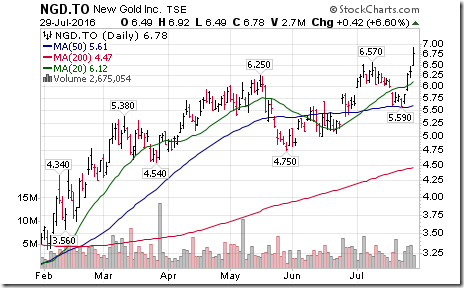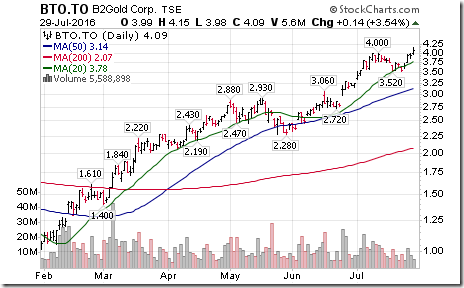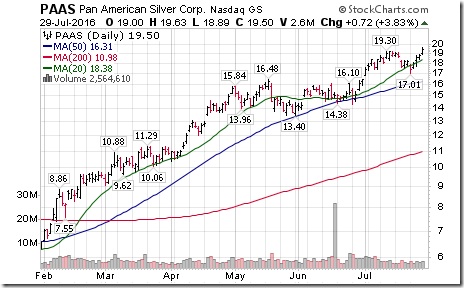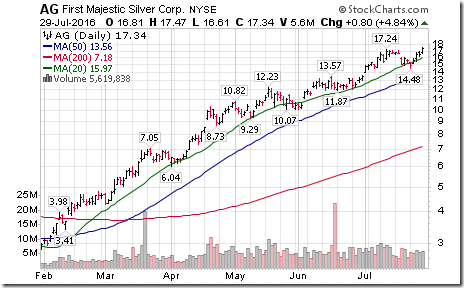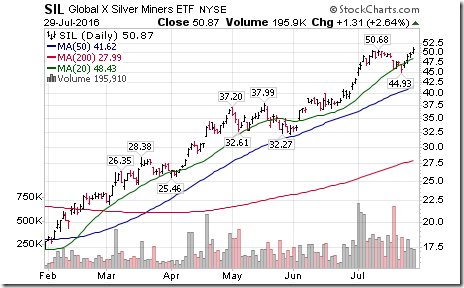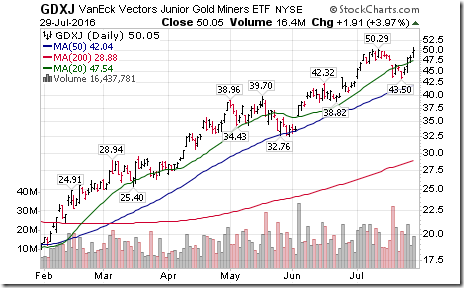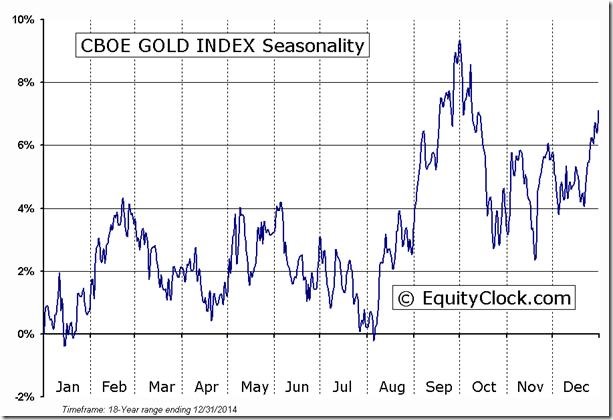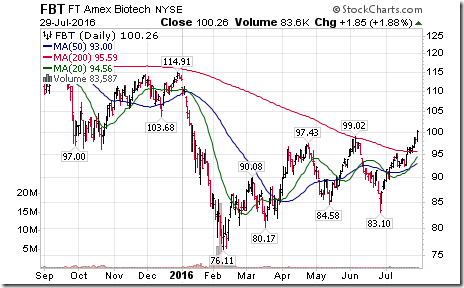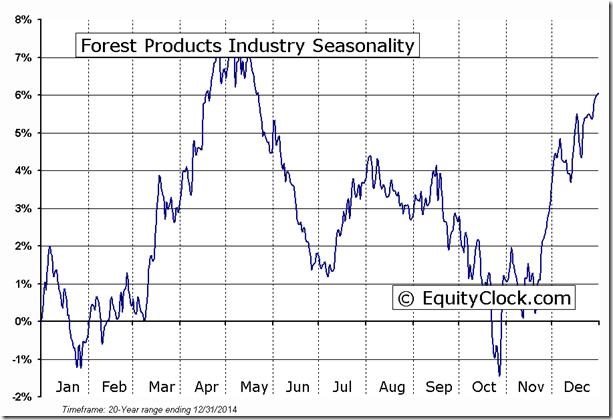by Don Vialoux, Timingthemarket.ca
Economic News This Week
July Personal Income to be reported at 8:30 AM EDT on Tuesday is expected to increase 0.3% versus a gain of 0.2% in June. July Personal Spending is expected to increase 0.3% versus a gain of 0.4% in June
July ADP July Private Employment to be reported at 8:15 AM EDT on Wednesday is expected to drop to 165,000 from 172,000 in June.
July ISM Services to be reported at 10:00 AM EDT on Wednesday are expected to slip to 55.8 from 56.5 in June
Weekly Initial Claims to be released at 8:30 AM EDT on Thursday are expected to slip to 264,000 from 266,000 last week.
June Factory Orders to be released at 10:00 AM EDT on Thursday are expected to drop 1.9% versus a decline of 1.0% in May.
July Non-farm Payrolls to be released at 8:30 AM EDT on Friday are expected to drop to 185,000 from 287,000 in June. July Private Non-farm Payrolls are expected to fall to 171,000 from 265,000 in June. July Unemployment Rate is expected to slip to 4.8% from 4.9% in June. July Hourly Earnings are expected to increase 0.2% versus a gain of 0.1% in June.
June U.S. Trade Deficit to be released at 8:30 AM EDT on Friday is expected to increase to $42.7 billion from $41.1 billion in May.
Canadian July Employment to be released at 8:30 AM EDT on Friday is expected to increase 10,000 versus a decline of 700 in June. July Unemployment Rate is expected to increase to 6.9% from 6.8%.
Canadian June Merchandise Trade Deficit to be released at 8:30 AM EDT on Friday is expected to drop to $2.6 billion from $3.3 billion in May.
Earnings Reports This Week
The Bottom Line
Technical, seasonal and fundamental factors point to a strong possibility of start of an intermediate correction by equity markets and economic sensitive sectors. Traders and seasonal investors should respond accordingly.
Observations
Historically, an unexpected event (e.g. China blowing up last summer, Ebola and Ukraine incidents in 2014, Greece blowing up in 2013) has occurred between the middle of June and the middle of October that triggered a significant increase in equity market volatility (and a corresponding correction). The event(s) that will trigger the volatility this summer is not clear. Possibility include increased terrorist activity, the U.S. Presidential election and instability by European financial institutions (Italian banks?).
Historically, the end of July has been an important seasonal inflection point for a wide variety of equity markets, commodities and economically sensitive sectors. Most move from Positive/Neutral to Neutral/Negative. The exception is the precious metals sector and the start of its period of seasonal strength
On average during the past 50 years, the S&P 500 Index has reached a seasonal summer peak on July 17th. Ditto for the TSX Composite Index during the past 20 years! During the past two weeks, both indices were virtually unchanged.
Short term technical indicators (i.e. Daily Stochastics, RSI and MACD) for most North American equity indices, commodities and economic sensitive sectors (with the exception of the precious metals sector) have rolled over from overbought levels
Intermediate technical indicators (i.e. S&P 500 and TSX composite Bullish Percent indices and Momentum Barometers) have rolled over from intermediate overbought levels.
The lower than expected first estimate of second quarter real U.S.GDP released on Friday was a shock. Consensus was growth at a 2.5% annual rate. Actual was 1.2%. The report implied that the Federal Reserve will maintain the Fed Fund rate at 0.25%-0.50% for a longer period, possibly into 2017. Bond prices rallied, the U.S. Dollar plunged and gold prices moved higher. Full response to the report has yet to reach the market. Look for economists to significantly lower their GDP estimates for 2016 and 2017 this week.
Economic focus this week is on the July Employment report to be released on Friday. Data from this and other U.S. economic reports this week are expected to show slow but steady economic growth.
Responses to second quarter reports released to date have been mixed at best (with some major exceptions on the upside and downside). 63% of S&P 500 companies have reported to date. Blended earnings on a year-over-year basis were down 3.7% while blended revenues were up 0.1%. 71% of reporting companies reported higher than consensus earnings and 57% reported higher than consensus revenues.
Earnings reports scheduled for release this week are expected to be less sanguine. Another 118 S&P 500 companies and two Dow Jones Industrial companies are scheduled to report this week. Focus is on the energy sector where year-over-year earnings and revenues are expected to be significantly lower.
Prospects beyond the second quarter have become less encouraging. 36 S&P 500 companies have issued negative third quarter guidance and 20 companies have issued positive guidance. Consensus estimates for the third and fourth quarter continue to drop. According to FactSet, third
quarter earnings by S&P 500 companies are expected to fall 0.6% (down from 0.3% last week) and fourth quarter earnings are expected to increase 6.3% (down from 6.6% last week).
Earnings by major Canadian companies start to pour in this week. Average (median) for Canada’s top 60 companies call for no change in earnings per share on a year-over-year basis.
Volatility in world currencies on Friday was scary, typically an event that triggers greater volatility in equity markets. Until, now, the VIX Index has bumped along long term support.
Equity Indices and Related ETFs
Daily Seasonal/Technical Equity Trends for July 29th 2016
Green: Increase from previous day
Red: Decrease from previous day
Calculating Technical Scores
Technical scores are calculated as follows:
Intermediate Uptrend based on at least 20 trading days: Score 2
Higher highs and higher lows
Intermediate Neutral trend: Score 0
Not up or down
Intermediate Downtrend: Score -2
Lower highs and lower lows
Outperformance relative to the S&P 500 Index: Score: 2
Neutral Performance relative to the S&P 500 Index: 0
Underperformance relative to the S&P 500 Index: Score –2
Above 20 day moving average: Score 1
At 20 day moving average: Score: 0
Below 20 day moving average: –1
Up trending momentum indicators (Daily Stochastics, RSI and MACD): 1
Mixed momentum indicators: 0
Down trending momentum indicators: –1
Technical scores range from -6 to +6. Technical buy signals based on the above guidelines start when a security advances to at least 0.0, but preferably 2.0 or higher. Technical sell/short signals start when a security descends to 0, but preferably -2.0 or lower.
Long positions require maintaining a technical score of -2.0 or higher. Conversely, a short position requires maintaining a technical score of +2.0 or lower
The S&P 500 Index slipped 1.43 points (0.07%) last week. The Index briefly touched an all-time high on Friday. Intermediate trend remains up. The Index remains above its 20 day moving average. Short term momentum indicators recently turned down from overbought levels.
Percent of S&P 500 stocks trading above their 50 day moving average (Also known as the S&P 500 Momentum Barometer) slipped last week to 75.60% from 86.20%. Percent is intermediate overbought and has started to trend down.
Percent of S&P 500 stocks trading above their 200 day moving average slipped last week to 77.40% from 79.40%. Percent remains intermediate overbought and showing early signs of rolling over.
Bullish Percent Index for S&P 500 stocks increased last week to 74.80% from 74.20% and remained above its 20 day moving average. The Index remains intermediate overbought.
Bullish Percent Index for TSX Composite stocks increased last week to 80.83% from 77.92% and remained above its 20 day moving average. The Index remains intermediate overbought.
The TSX Composite Index slipped 17.94 points (0.12%) last week. Intermediate trend remains up (Score: 2). Strength relative to the S&P 500 Index remains neutral (Score: 0). The Index remains above its 20 day moving average (Score: 1). Short term momentum indicators turned down (Score: -1). Technical score slipped last week to 2 from 4
Percent of TSX stocks trading above their 50 day moving average (Also known as the TSX Momentum Barometer) dropped last week to 69.53% from 75.54%. Percent remains intermediate overbought and is trending down.
Percent of TSX stocks trading above their 200 day moving average slipped last week to 79.40% from 79.83%. Percent remains intermediate overbought and showing early signs of rolling over.
The Dow Jones Industrial Average dropped 138.61 points (0.75%) last week. Intermediate trend remains up. Strength relative to the S&P 500 Index changed last week to negative from neutral. The Average remains above its 20 day moving average. Short term momentum indicators have turned down. Technical score dropped last week to 0 from 6.
Bullish Percent Index for Dow Jones Industrial Average stocks was unchanged last week at 86.67% and remained above its 20 day moving average. The Index remains intermediate overbought.
Bullish Percent Index for NASDAQ Composite stocks increased last week to 60.08% from 58.70% and remained above its 20 day moving average. The Index remains intermediate overbought.
The NASDAQ Composite Index added 61.97 points (1.22%) last week. Intermediate trend remains up. Strength relative to the S&P 500 Index remains positive. The Index remains above its 20 day moving average. Short term momentum indicators are trending up and are overbought, but have yet to show signs of peaking. Technical score remained last week at 6.
The Russell 2000 Index added 7.05 points (0.58%) last week. Intermediate trend remains up. Strength relative to the S&P 500 Index remains positive. The Index remains above its 20 day moving average. Short term momentum indicators are trending up and are overbought. Technical score remained last week at 6.
The Dow Jones Transportation Average added 119.57 points (1.50%) last week. Intermediate trend remains neutral. Strength relative to the S&P 500 Index remains neutral. The Average remains above its 20 day moving average. Short term momentum indicators are trending down. Technical score remained last week at 2.
The Australia All Ordinaries Composite Index added 69.70 points (1.25%) last week. Intermediate trend remains up. Strength relative to the S&P 500 Index improved to positive from neutral. The Index remains above its 20 day moving average. Short term momentum indicators are trending up, but are overbought. Technical score improved last week to 6 from 4.
The Nikkei Average dropped 240.95 points (1.43%) last week. Intermediate trend remains down. Strength relative to the S&P 500 Index remains neutral. The Average remained above its 20 day moving average. Short term momentum indicators have turned down. Technical score slipped last week to -2 from 0.
Europe iShares added $0.72 (1.88%) last week. Intermediate trend remains down. Strength relative to the S&P 500 Index changed last week to positive from negative. Units remained above their 20 day moving average. Short term momentum indicators are trending up. Technical score improved last week to 2 from -2.
The Shanghai Composite Index dropped 33.58 points (1.11%) last week. Intermediate trend remains up. Strength relative to the S&P 500 Index changed to negative from neutral. The Index dropped below its 20 day moving average. Short term momentum indicators are trending down. Technical score dropped last week to -2 from 2.
Emerging Markets iShares added $0.24 (0.67%) last week. Intermediate trend remains up. Strength relative to the S&P 500 Index remains positive. Units remain above their 20 day moving average. Short term momentum indicators are overbought and showing signs of rolling over. Technical score slipped last week to 4 from 6.
Currencies
The U.S. Dollar dropped 12.97 (2.02%) last week (including 1.24 on Friday). Intermediate trend remains up. The Dollar dropped below its 20 day moving average on Friday. Short term momentum indicators are trending down.
The Euro gained 2.03 (1.85%) last week in response to U.S. Dollar weakness. Intermediate trend changed to neutral on Friday. The Euro moved above its 20 day moving average. Short term momentum indicators are trending up.
The Canadian Dollar gained US 0.59 (0.78%) last week with all of the gain happening on Friday in response to U.S. Dollar weakness. Intermediate trend remains down. The Canuck Buck moved above its 20 day moving average on Friday. Short term momentum indicators turned higher on Friday.
The Japanese Yen added 3.65 (3.87%) last week. Intermediate trend remains up. The Yen moved above its 20 day moving average on Friday. Short term momentum indicators are trending up.
The British Pound gained 1.32 (1.01%) last week. Intermediate trend remains down. The Pound moved above its 20 day moving average. Short term momentum indicators are trending up.
Commodities
Daily Seasonal/Technical Commodities Trends for July 29th 2016
Green: Increase from previous day
Red: Decrease from previous day
The CRB Index dropped 0.71 (0.39%) last week. Intermediate trend remains down. Strength relative to the S&P 500 Index remains negative. The Index remained below its 20 day moving average. Short term momentum indicators are trending down. Technical score remained last week at 6.
Gasoline dropped $0.04 per gallon (2.94%) last week. Intermediate trend remains down. Strength relative to the S&P 500 Index remains negative. Gas remained below its 20 day moving average. Short term momentum indicators are trending down. Technical score remained at -6.
Crude Oil dropped $2.59 per barrel (5.86%) last week. Intermediate trend remains up. Strength relative to the S&P 500 Index remains negative. Crude remains below its 20 day moving average. Short term momentum indicators are trending down. Technical score remained last week at -2.
Natural Gas added $0.14 per MBtu (5.11%) last week in response to first signs of the summer hurricane season. Intermediate trend remains up. Strength relative to the S&P 500 Index improved to neutral from negative. “Natty” moved above its 20 day moving average. Short term momentum indicators turned higher. Technical score improved last week to 4 from -2.
The S&P Energy Index dropped 10.59 points (2.07%) last week. Intermediate trend remains up. Strength relative to the S&P 500 Index remained negative. The Index fell below its 20 day moving average. Short term momentum indicators are trending down. Technical score slipped last week to -2 from 0.
The Philadelphia Oil Services Index dropped 3.37 points (2.05%) last week. Intermediate trend changed to down from up on Friday when the Index briefly dropped below support at 157.64. Strength relative to the S&P 500 Index remained negative. The Index remained below its 20 day moving average. Short term momentum indicators are trending down. Technical score dropped last week to -6 from -2.
Gold gained $34.10 per ounce (2.58%) last week thanks mainly to late weakness in the U.S. Dollar Index. Intermediate trend remains up. Strength relative to the S&P 500 Index changed to neutral from negative. Gold remained above its 20 day moving average. Short term momentum indicators are trending up. Technical score improved last week to 4 from -2.
Silver gained $0.66 per ounce (3.35%) last week. Intermediate trend remains up. Strength relative to the S&P 500 Index remained neutral. Silver remained above its 20 day moving average. Short term momentum indicators are trending up. Technical score improved last week to 4 from 2. Strength relative to Gold remains positive.
The AMEX Gold Bug Index gained 15.25 points (5.89%) last week. Intermediate uptrend was confirmed on Friday on a move above 273.62. Strength relative to the S&P 500 Index remained neutral. The Index moved above its 20 day moving average. Short term momentum indicators are trending up. Technical score improved last week to 4 from 0. Strength relative to Gold remains positive.
Platinum gained $62.20 per ounce (5.71%) last week. Intermediate trend remains up. Relative strength remains positive. Trades above its 20 day moving average. Momentum: up.
Palladium gained $23.70 per ounce (3.45%) last week.Intermediate trend remains up. Strength relative to the S&P 500 Index remains positive. PALL remains above its 20 day moving average. Short term momentum indicators are trending up. Technical score last week remained at 6.
Copper slipped 0.015 per lb.(0.675) last week. Intermediate trend remains neutral. Strength relative to the S&P 500 Index remains neutral. Copper remained above its 20 day moving average. Short term momentum indicators are trending down. Technical score dropped last week to 0 from 2.
The TSX Metals & Mining Index gained 56.20 points (8.88%) last week. Intermediate uptrend was confirmed on a move above 669.54. Strength relative to the S&P 500 Index remained positive. The Index remained above its 20 day moving average. Short term momentum indicators returned to an uptrend. Technical score last week improved to 6 from 4.
Lumber dropped $10.70 (3.25%) last week. Intermediate trend remains up. Strength relative to the S&P 500 Index changed to negative from neutral on Friday. Lumber dropped below its 20 day moving average on Friday. Short term momentum indicators are trending down. Score:-2
The Grain ETN dropped another 0.20 (0.68%) last week. Trend remains down. Relative Strength remains negative. Units remain below their 20 day moving average. Momentum: Down
The Agriculture ETF slipped $0.06 (0.12%) last week. Intermediate trend remains neutral. Strength relative to the S&P 500 Index remains negative. Units remained above their 20 day moving average. Short term momentum indicators are trending down. Technical score remains at -2.
Interest Rates
The yield on 10 year Treasuries dropped 11.2 basis points (7.13%) last week. Intermediate trend remains down. Yield fell below its 20 day moving average on Friday. Short term momentum indicators are trending down.
Conversely, price of the long term Treasury ETF gained $2.76 (1.99%) last week. Intermediate trend remains up. Units moved back above their 20 day moving average on Friday. Short term momentum indicators are trending up.
Volatility
The Index slipped 0.15 (1.25%) last week. Intermediate trend remains down. The Index remains below its 20 day moving average.
Sectors
Daily Seasonal/Technical Sector Trends for March July 29th 2016
Green: Increase from previous day
Red: Decrease from previous day
StockTwits Released on Friday
S&P 500 Index has traded within the tightest 11 day span since 1995
Technical action by S&P 500 stocks to 10:00: Mixed. Breakouts: $HIG, $GOOG, $GOOGL, $VRSN, $RTN. Breakdowns: $APA, $HIG, $SRCL
Editor’s Note: After 10:00 AM EDT, breakouts included HRL, HOG and MPC. Breakdown: KR
More Canadian gold stocks breaking resistance extending uptrends: $NGD.CA $BTO.CA
Silver stocks also breaking resistance extending intermediate uptrends $PAAS
Silver Miners ETF $SIL moved above resistance at $50.68 extending intermediate uptrend
Junior Gold Equity ETF $GDXJ moved above resistance at $50.29 extending intermediate uptrend.
‘Tis the season for strength in Gold Equities! $GDX, $GDXJ, $XGD.CA
Nice break by First Trust Biotech ETF $FBT above $99.02 extending intermediate uptrend. ‘Tis the season for strength!
Special Free Services available through www.equityclock.com
Equityclock.com is offering free access to a data base showing seasonal studies on individual stocks and sectors. The data base holds seasonality studies on over 1000 big and moderate cap securities and indices. To login, simply go to http://www.equityclock.com/charts. Following is an example:
Editor’s Note: The start of the second annual period of seasonal weakness in the forest product sector at the end of July was mentioned during Michael Campbell’s radio show on Saturday.
WALL STREET RAW RADIO – SATURDAY – JULY 30, 2016 – WITH MARK LEIBOVIT
AND SPECIAL GUESTS SINCLAIR NOE AND ARCH CRAWFORD – http://tinyurl.com/gw2aq6n
Disclaimer: Seasonality and technical ratings offered in this report by www.timingthemarket.ca and www.equityclock.com are for information only. They should not be considered as advice to purchase or to sell mentioned securities. Data offered in this report is believed to be accurate, but is not guaranteed
Copyright © DV Tech Talk, Timingthemarket.ca






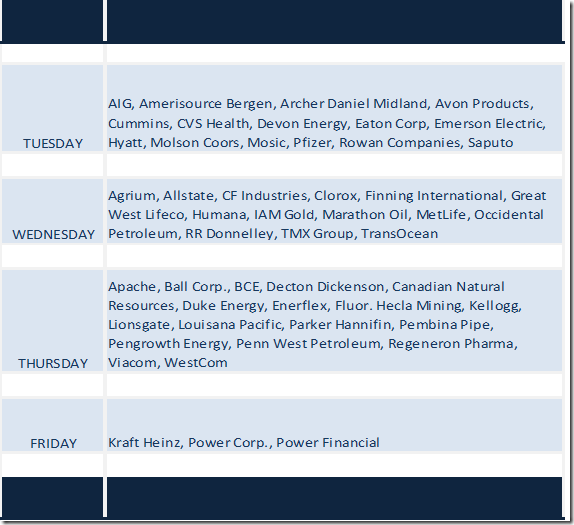
![clip_image002[6] clip_image002[6]](https://advisoranalyst.com/wp-content/uploads/2019/08/fc675773f65b7fa865cfb76481f7dcef.png)
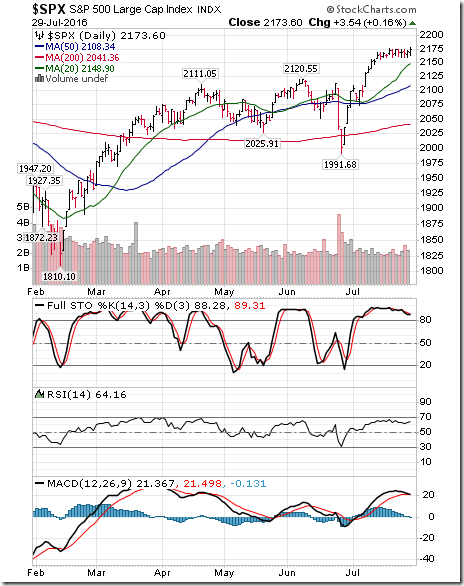
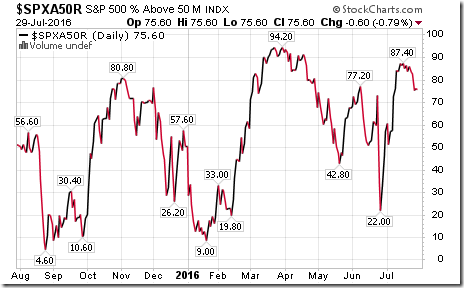
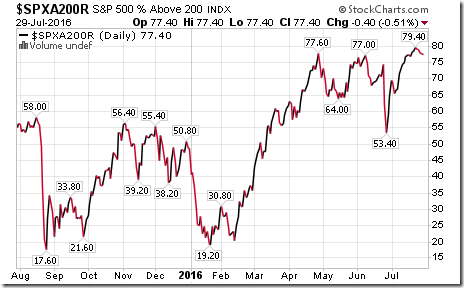
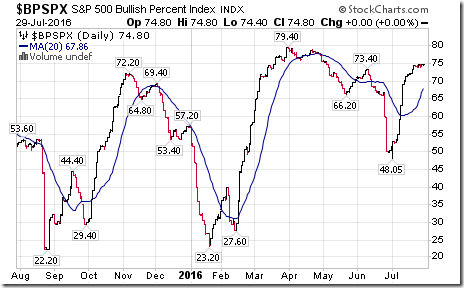
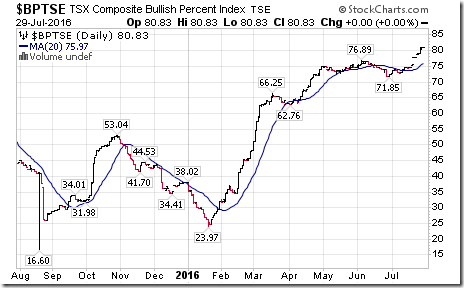
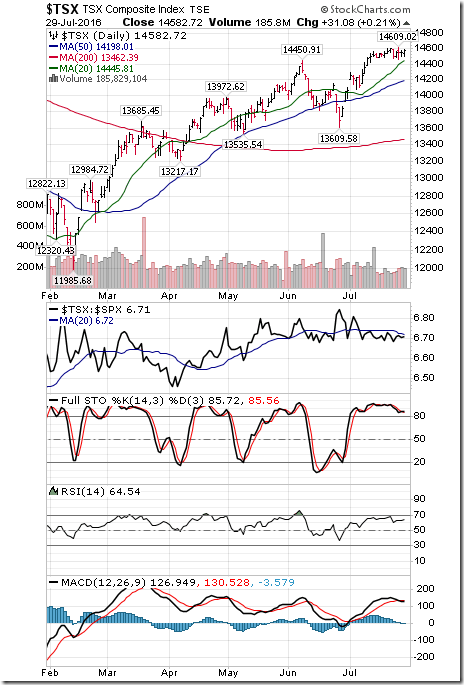
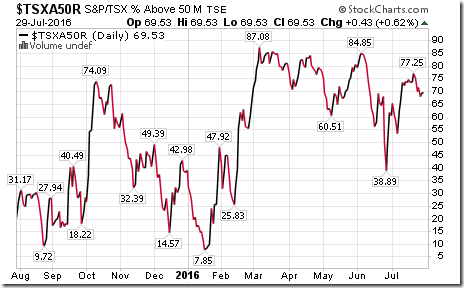
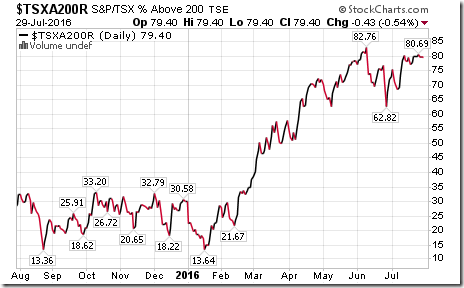
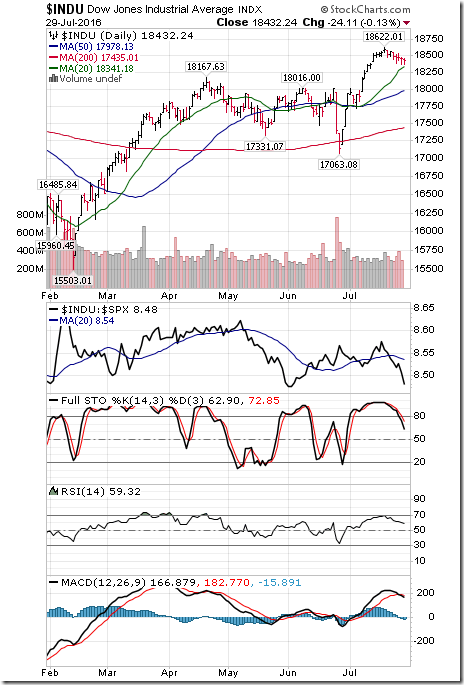
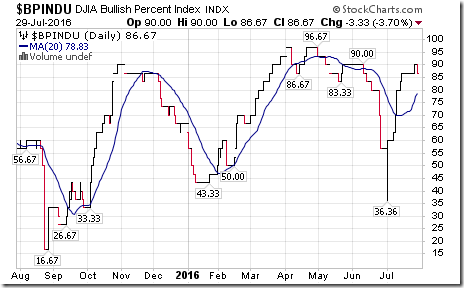
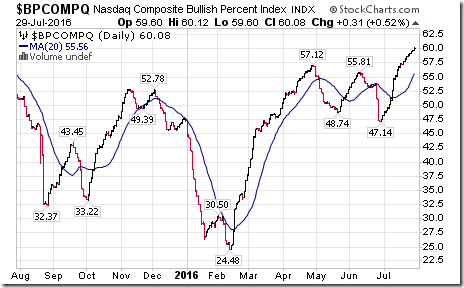
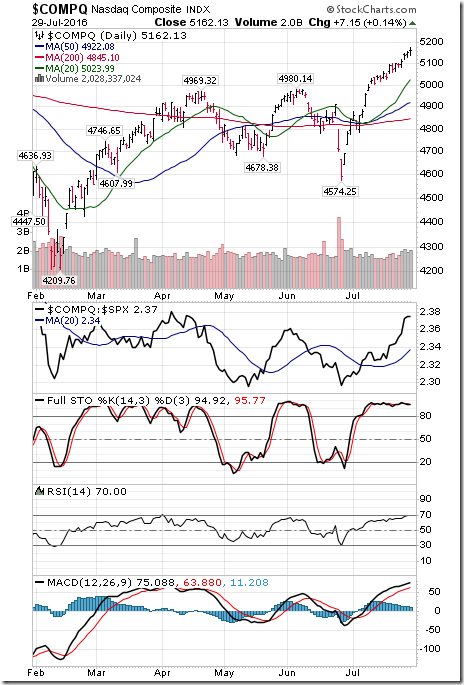
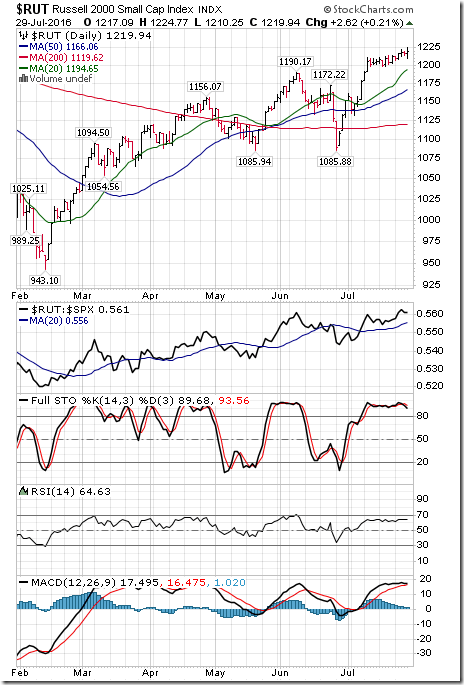
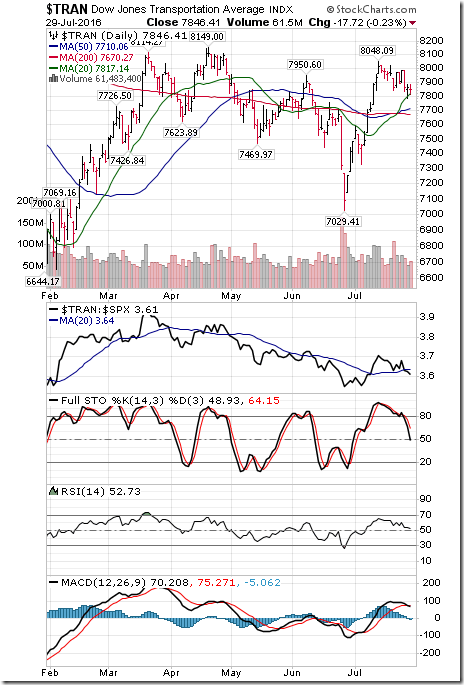
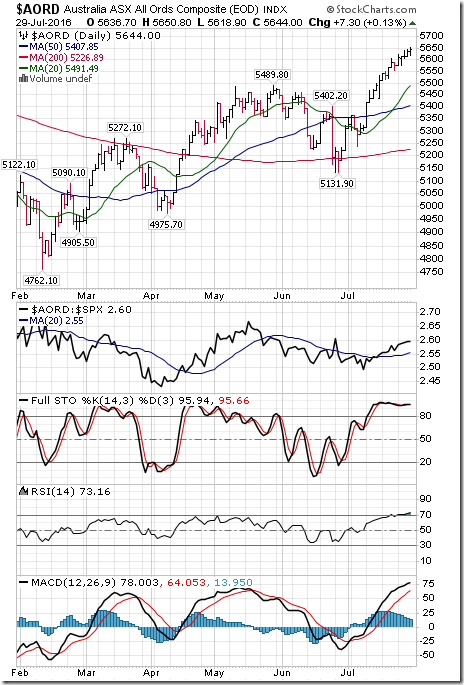
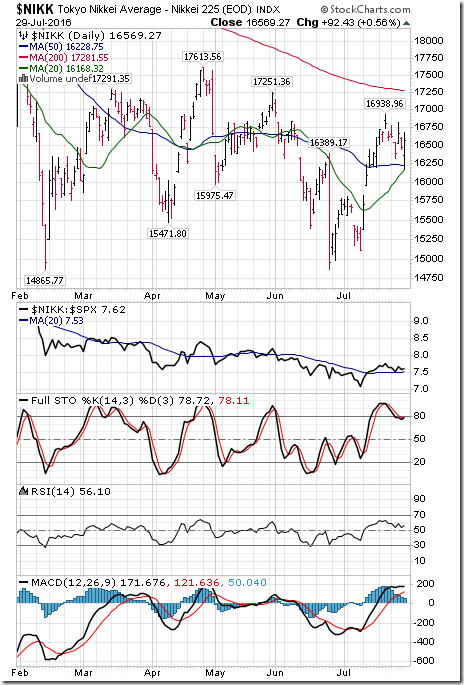
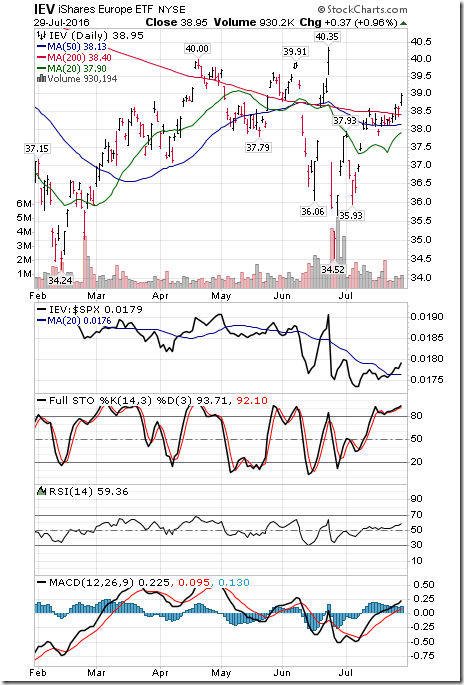
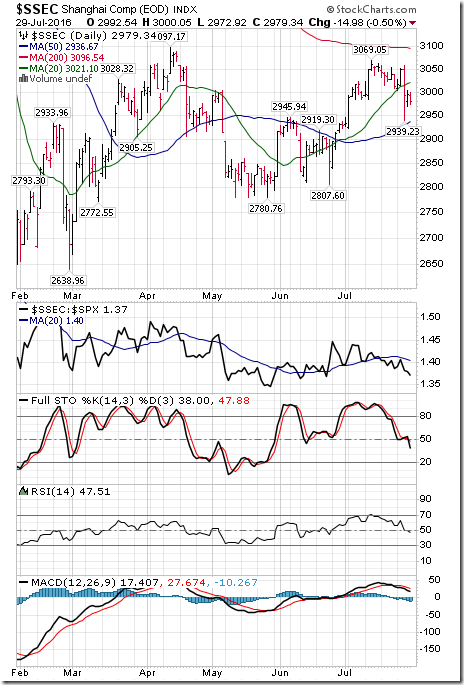
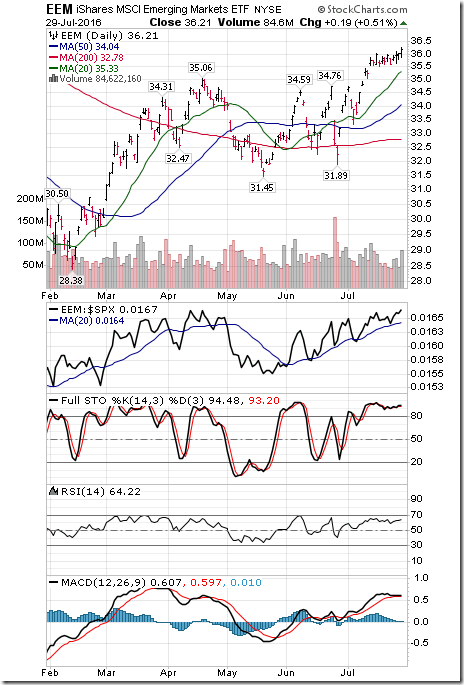
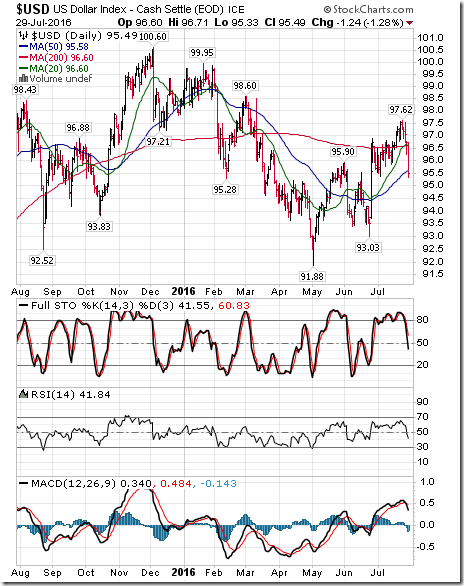
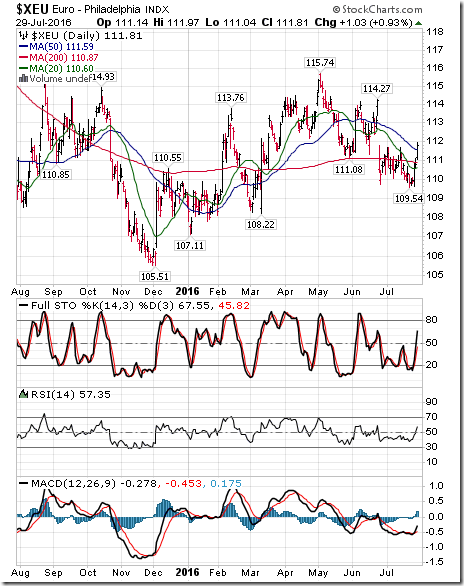
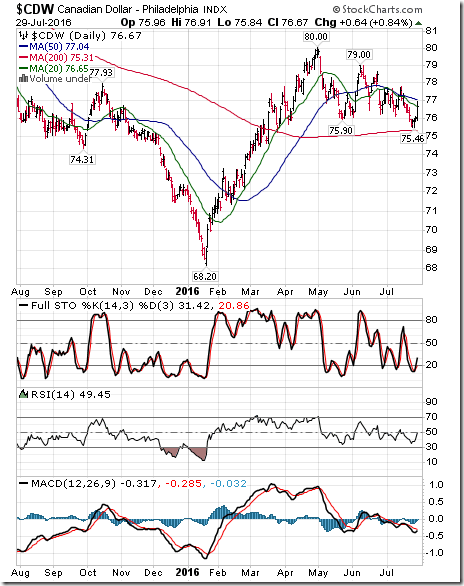
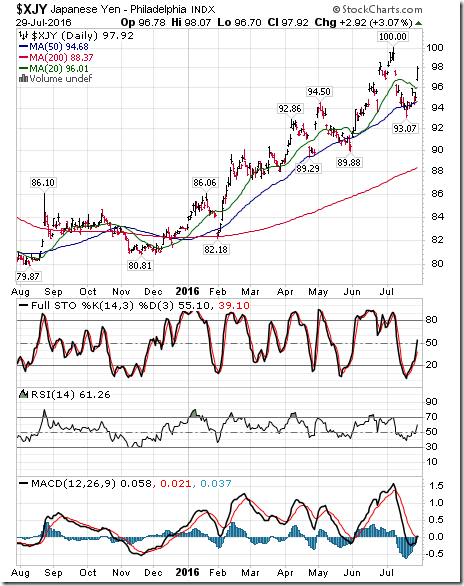
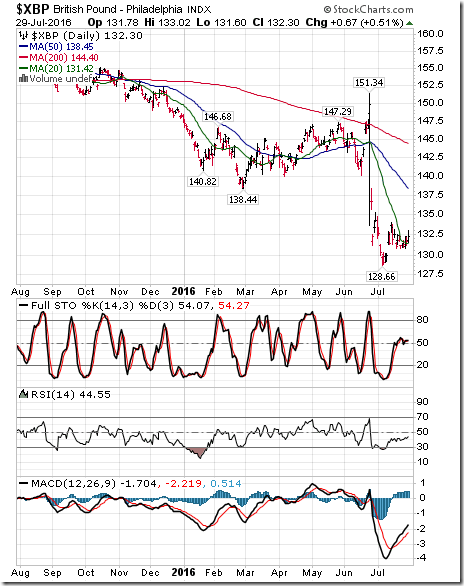
![clip_image002[8] clip_image002[8]](https://advisoranalyst.com/wp-content/uploads/2019/08/e8645731a708c3f4ca924d2975dd90b7.png)
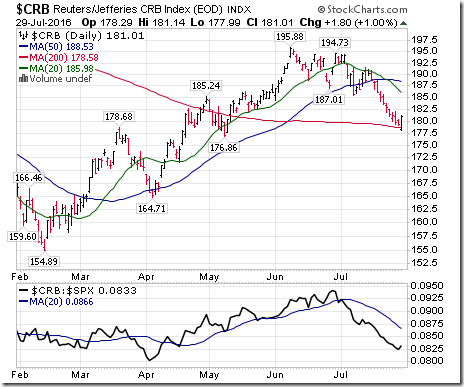
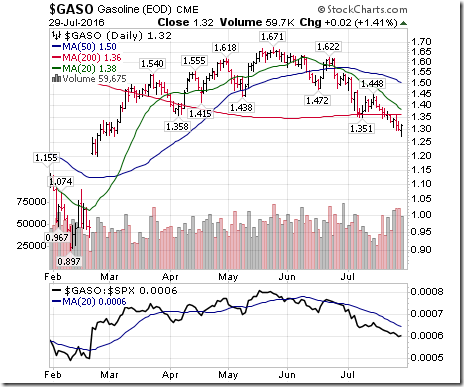
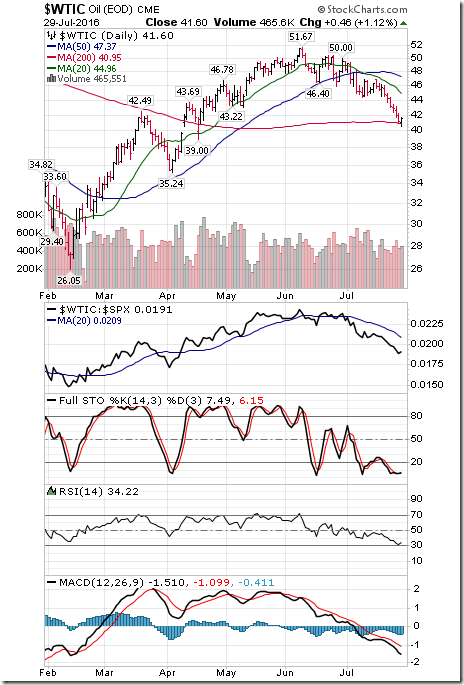
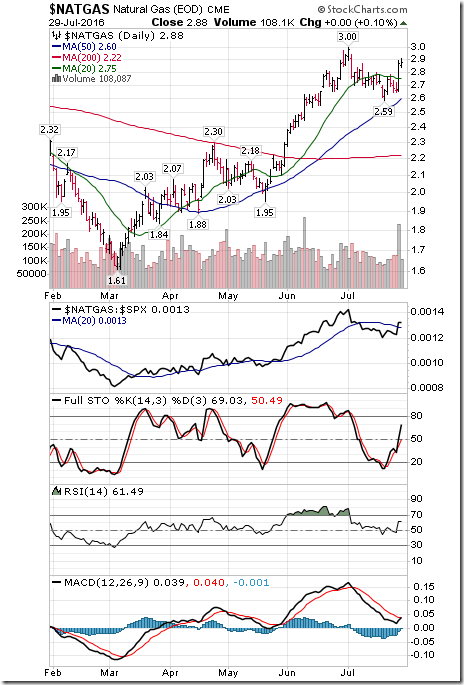
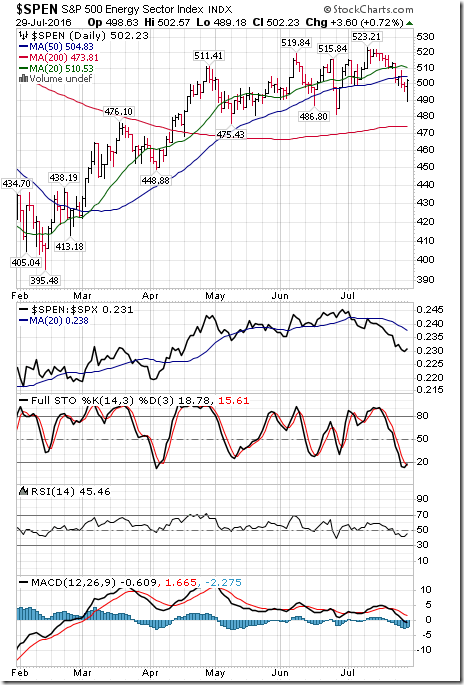
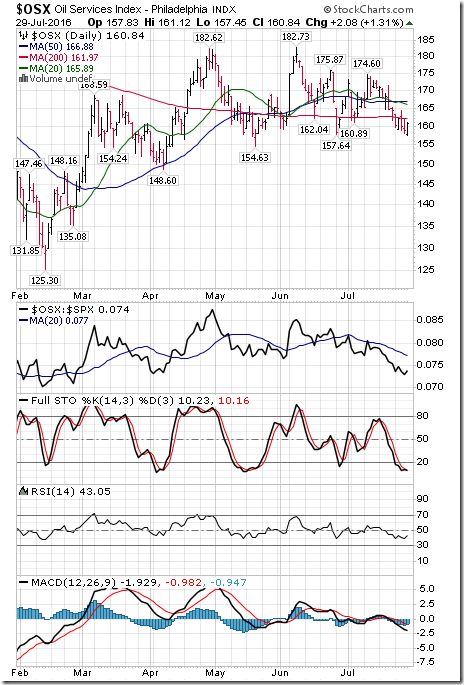
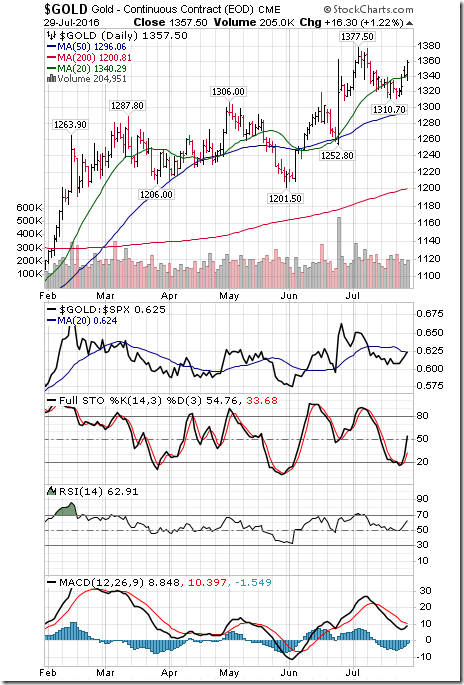
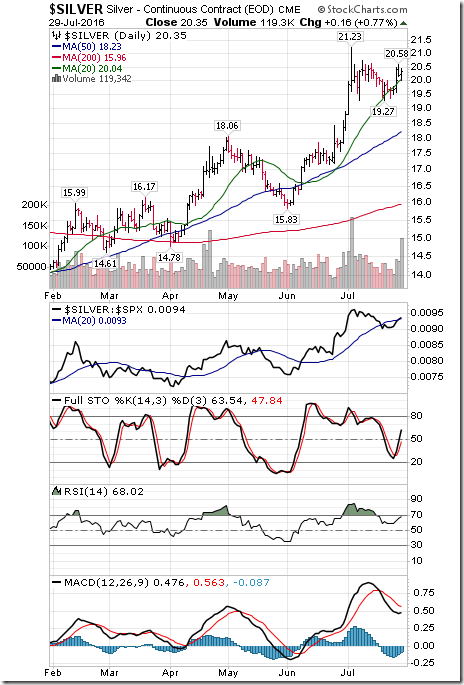
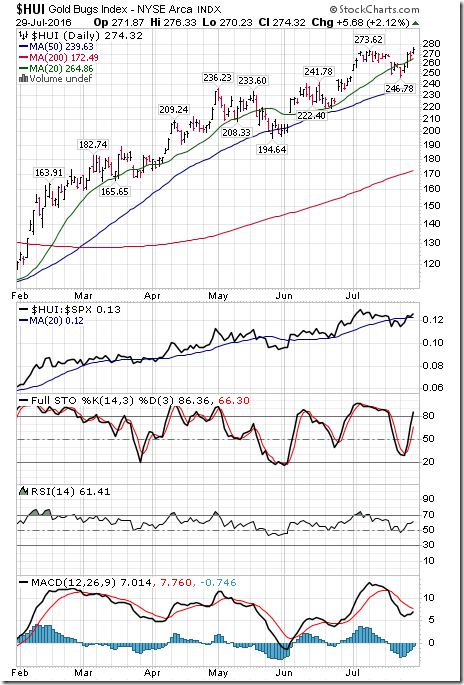
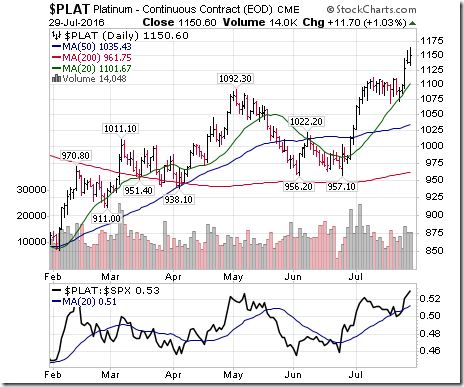
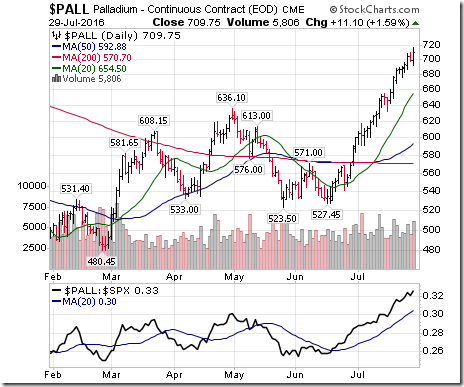
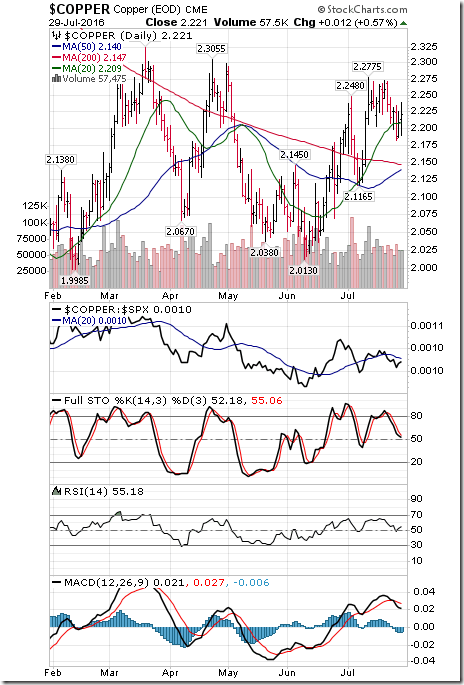
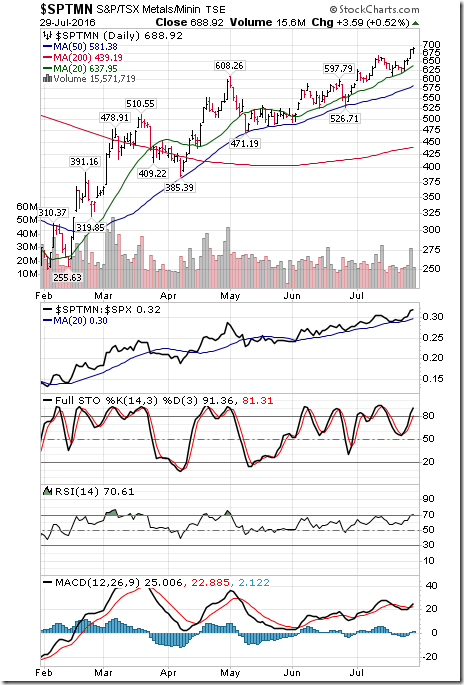
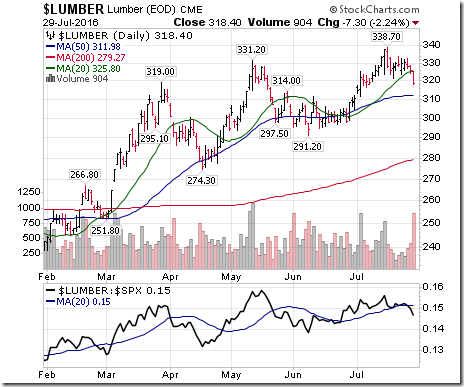
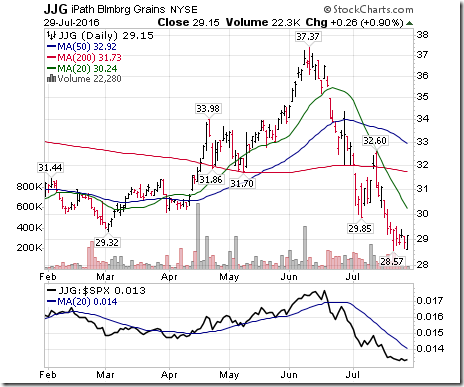
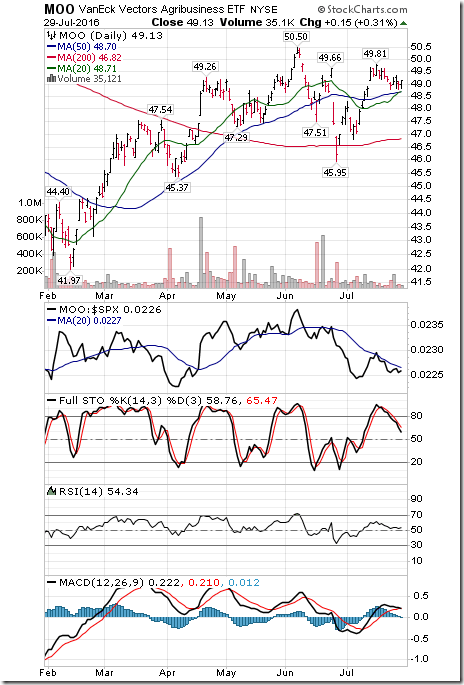
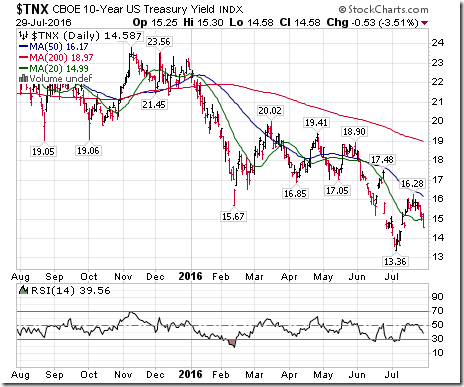
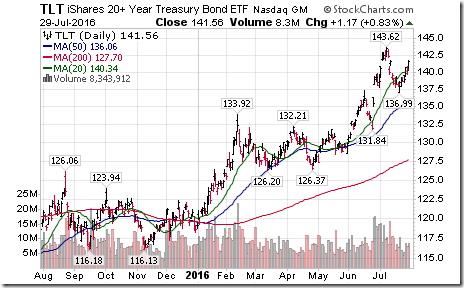
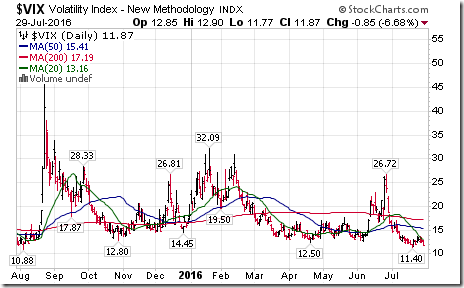
![clip_image002[10] clip_image002[10]](https://advisoranalyst.com/wp-content/uploads/2019/08/5d5b83684204fc801ab767b5dccb0f5b.png)
